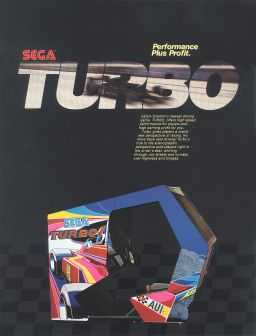Turbo (video game)
| Turbo | |
|---|---|
 North American arcade flyer | |
| Developer(s) | Sega |
| Publisher(s) | Sega |
| Designer(s) | Steve Hanawa |
| Platform(s) | Arcade |
| Release date(s) | 1981 |
| Genre(s) | Arcade-style racing |
| Mode(s) | Single-player |
| Cabinet | Standard and Sit-down |
Turbo is a racing game released in 1981 by Sega. The game was manufactured three formats: standard upright, cabaret/mini, and a seated environmental/cockpit. All three versions feature a steering wheel, a gearshift for low and high gears, and an accelerator pedal. The screen is a vertically oriented 20-inch raster display. In addition to the on-screen display, Turbo features an LED panel to the left of the screen that displays the current player's score and the high score table. Turbo also features lighted oil and temperature gauges on either side of the steering wheel.[1]
Gameplay
Turbo requires the player to navigate a road race through different urban and rural locations, through differing weather conditions, and during changing times of day. The cars in the game resemble Formula 1 race cars. The player is required to pass and stay ahead of at least 30 competing cars before time expires. Collisions with CPU-controlled vehicles will cause the player's car to explode. Some CPU-controlled opponents drive predictably, while others swerve across the road suddenly. In the first round, the player has unlimited lives. In subsequent rounds, the player is limited to three lives, and awarded an additional life (up to a total of four) for each completed round. In addition to competing racers, an ambulance occasionally comes along from behind and overtakes the player; it too must be avoided, as contact with it will cost the player a life.
Development and Legacy
Turbo was designed and coded by Steve Hanawa. In an interview, Hanawa stated that despite its historical significance as a precedent-setting racing video game, he considers the process of creating it to have been his worst development experience at Sega. Development of Turbo required such a difficult and protracted schedule of coding and debugging that he was hospitalized for a month following its completion due to stress, exhaustion and a spontaneously collapsed lung.[2]
Turbo set many precedents in racing video game design, several of which are still standard today. Turbo was the first full-color raster display racing game to feature the now common third-person perspective, rear-view racer format. It was the first third-person racing game to feature scaling sprites of competing AI drivers, trees, and cityscape elements (including skyscrapers as tall as the screen). It was the first third-person racing game to feature multiple landscapes (cities, countrysides, seasides, bridges, and tunnels), as well as the first racing game to feature different times of day and different weather conditions (clear weather and snow). Turbo was also the first third-person racing video game to feature hills in its race course.
Turbo was one of the most popular arcade games of 1981 and was ported to the Colecovision and Intellivision home consoles. An Atari 2600 port by Coleco was in development at one point, but it was subsequently cancelled before release. Although advertised by Coleco and featured at the 1983 Consumer Electronics Show, it was never completed, due in part to the lead programmer, Michael Green, having been struck and seriously injured by a drunk driver while riding a bicycle. The deadline for completing the game was subsequently missed. By the time the production of the conversion was able to resume, the video game market's infamous 1983 collapse was well under way, and Coleco opted not to release the game. The prototype, estimated to be about 80% complete, was found by another Coleco programmer, Anthony Henderson, in his attic in 2006.[3] A Turbo board game was released by Milton Bradley in 1983.[4]
In popular culture
The upright cabinet of Turbo is seen in Rainbow's video for "Death Alley Driver."
Turbo was featured in the film Koyaanisqatsi.
References
- ↑ http://www.arcade-museum.com - Turbo - video game by Sega
- ↑ http://www.smstributes.co.uk - Steve Hanawa's Tech Talk
- ↑ http://www.atariage.com - Turbo - AtariAge
- ↑ http://segaretro.org - Turbo - Sega Retro